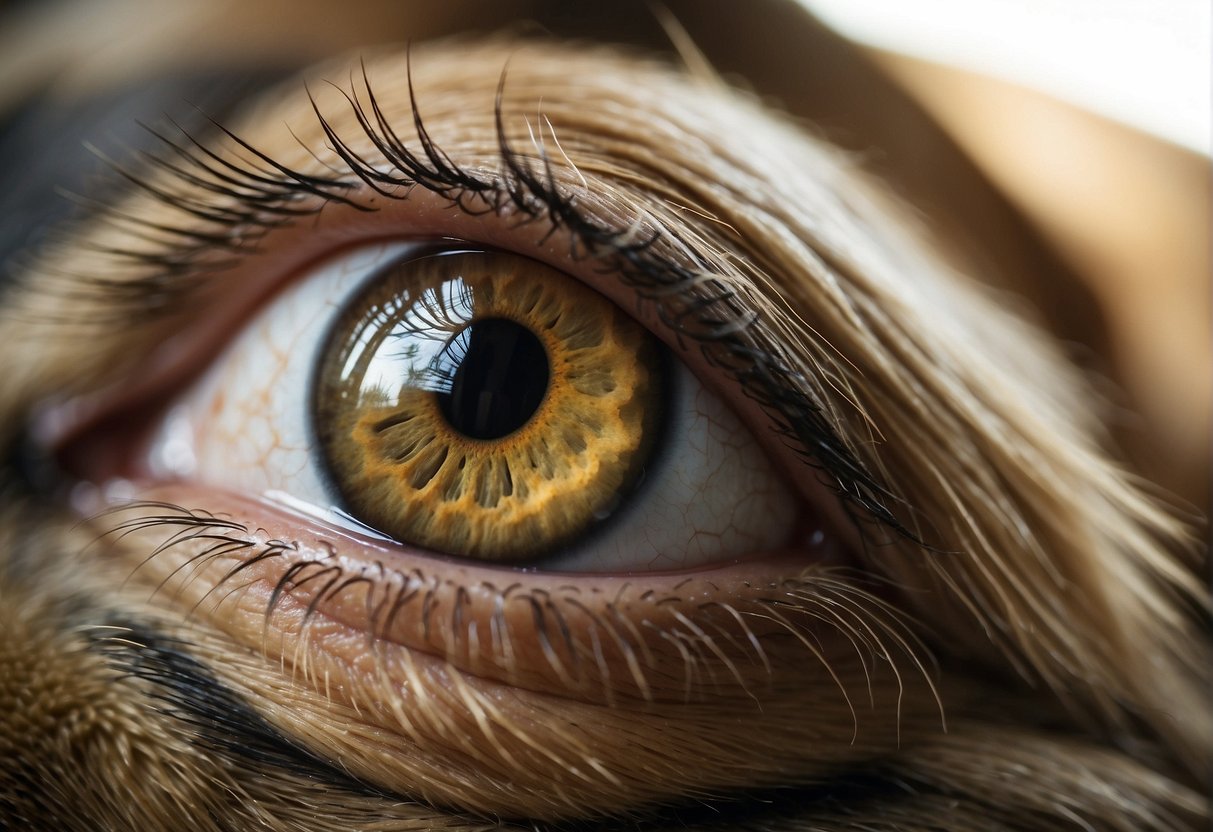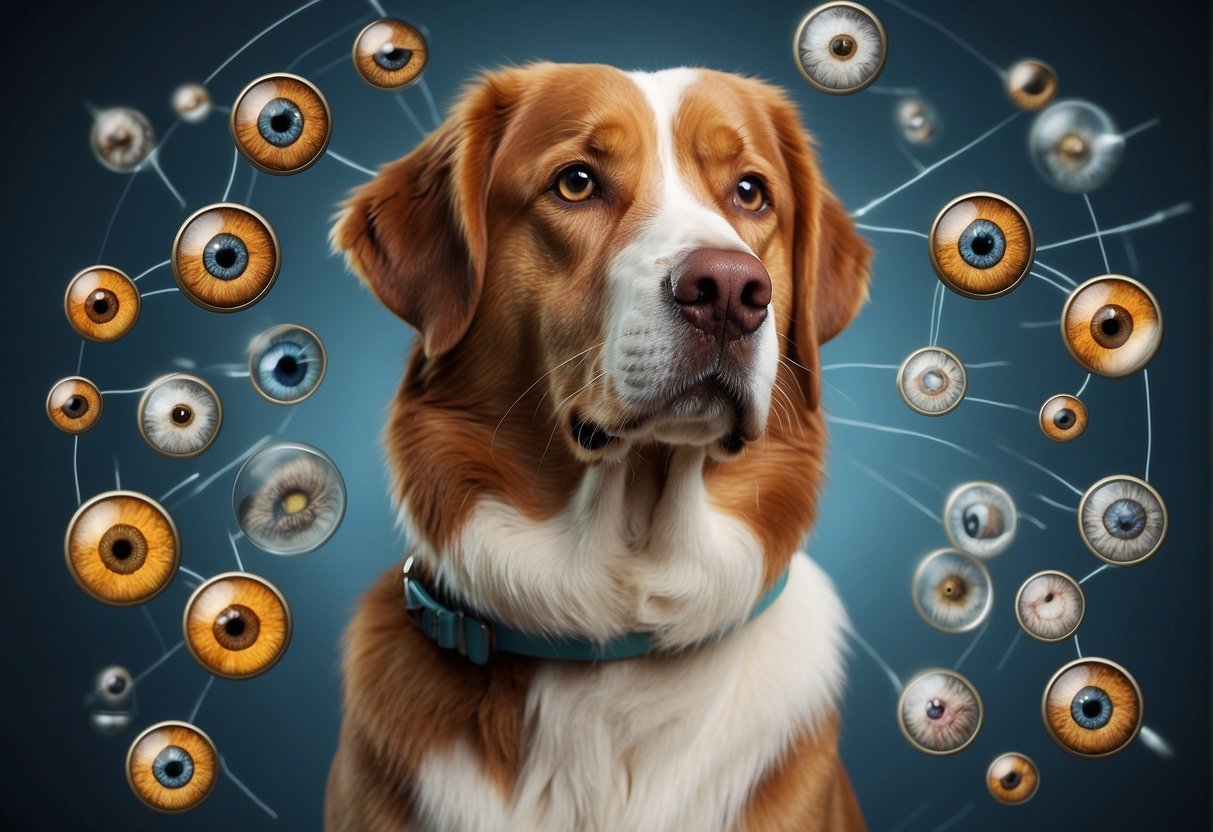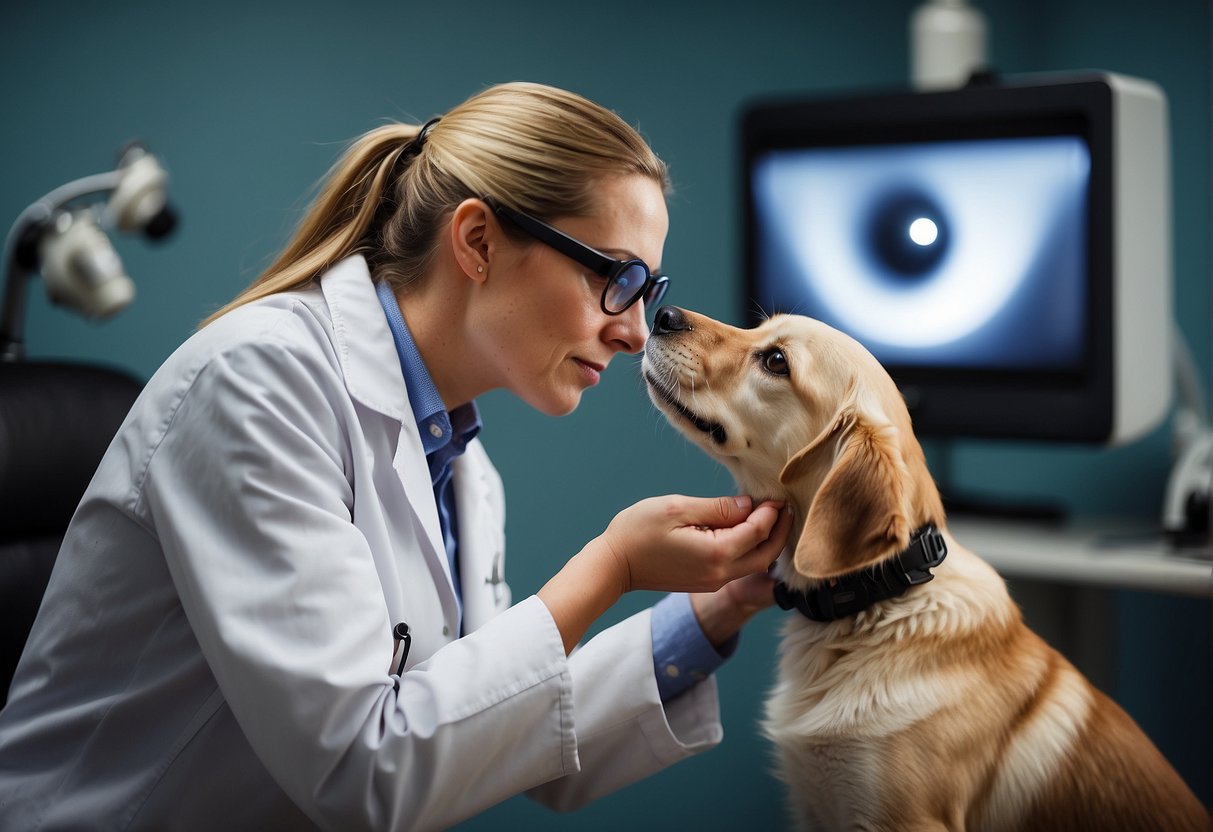The health of a dog’s eyes can often reflect their overall systemic health.
Conditions like diabetes, high blood pressure, and various infectious diseases have the potential to impact a dog’s eyesight.
In particular, senior dogs are more susceptible to systemic illnesses that can lead to eye diseases.
Conditions such as cataracts, retinal dysplasia, and glaucoma in dogs may signal underlying health issues, making it imperative for pet owners to pay close attention to their dog’s eye health.

Veterinarians frequently observe that eye problems in dogs, such as iridocyclitis and choroiditis, can be manifestations of systemic diseases including tick-borne diseases like ehrlichiosis and anaplasmosis.
These diseases can cause ocular signs that not only affect a dog’s vision but also assist in the overall diagnosis and management of their condition.
Understanding the connection between systemic health and eye conditions in dogs is critical for early detection and treatment, potentially saving a dog’s sight.
Genetics also play a role in the intersection of systemic health and ocular conditions.
Specific breeds are predisposed to certain eye conditions linked with systemic diseases.
For example, merle coloration in dogs has been associated with eye defects such as microphthalmia and cataracts.
Awareness and responsible breeding practices are crucial to prevent these hereditary health issues.
Being informed about these connections helps dog owners and breeders make better healthcare decisions for their canine companions.
Understanding Canine Ocular Anatomy and Health

The eye of a dog is a complex organ that is quite similar to that of a human in structure and function.
Central to their vision is the retina, a layer of tissue at the back of the eye that captures light and sends signals to the brain.
Proper functioning of the retina is vital for a dog’s vision quality and overall eye health.
In front of the retina lies the iris, the colorful part of the eye.
The iris regulates the amount of light that enters the eye by adjusting the size of the pupil.
Another critical component is the cornea, a transparent layer that covers the front of the eye, providing most of the eye’s optical power.
Canines are also susceptible to uveitis, an inflammation of the uvea, which includes the iris, ciliary body, and choroid.
Uveitis can be indicative of underlying systemic health problems.
The conjunctiva, a thin membrane covering the eye, can become inflamed, leading to pink eye or conjunctivitis, which may signal allergies or infections.
Tear production is essential for maintaining eye health, providing nourishment, and keeping the cornea clear and free from infections.
Insufficient tear production can result in dry eyes, leading to discomfort and potential damage to the corneal surface.
Occasionally, dogs may develop ocular abnormalities, such as cataracts or glaucoma, affecting their vision and quality of life.
Ocular diseases in dogs can often have systemic health implications, making regular eye exams critical for early detection and treatment.
Monitoring and maintaining canine ocular health is a step towards ensuring a pet’s overall well-being.
Common Eye Diseases in Dogs and Their Systemic Links

Eye health in dogs is often reflective of their overall systemic health.
Conditions such as diabetes and high blood pressure can lead to serious eye problems, some of which can result in loss of vision if not identified and managed appropriately.
Cataracts and Systemic Disease
Cataracts in dogs can lead to cloudiness and ocular opacity.
They are frequently linked to metabolic disorders, diabetes mellitus being a prominent cause where the excess blood sugar levels lead to lens damage.
Moreover, hypocalcemia, another metabolic irregularity, is known to be associated with cataract formation in canines.
Glaucoma and Related Systemic Issues
Glaucoma in dogs is characterized by increased intraocular pressure, which can ultimately harm the optic nerve.
Secondary glaucoma, in particular, might arise from systemic issues such as inflammation from conditions like uveitis.
It’s important to understand that glaucoma could be a sign of other deep-rooted systemic diseases, including those related to abnormal adrenal gland function, indicative of diseases like hyperadrenocorticism.
Retinal Disorders and Their Connection to Overall Health
Retinal ailments, such as retinal detachment, are often related to systemic health problems.
Conditions like hypertension are recognized causes of retinal detachment and subsequent vision loss especially in senior dogs.
Additionally, systemic infections can manifest ocularly as chorioretinitis or retinitis, suggesting the need for examination and treatment beyond the eyes themselves.
Retinal dysplasia and edema are also representative of underlying genetic or systemic issues.
Diagnosing Eye Conditions: The Role of Veterinary Ophthalmologists

Veterinary ophthalmologists are key players in the health of canines, dedicated to the diagnosis and management of eye conditions.
They use a range of diagnostic techniques to detect issues early and initiate treatment.
Importance of Early Detection
Early detection of eye conditions in dogs is crucial, as it can prevent irreversible damage and preserve vision.
Regular examinations by a veterinary ophthalmologist are essential, especially for senior dogs, since early signs of eye diseases or age-related changes can be subtle.
A detailed eye evaluation at each routine checkup can spot issues before they become more serious.
Diagnostic Techniques and Considerations
Diagnostic Tools:
- Schirmer Tear Test: This test measures tear production and is essential for diagnosing dry eye, a common issue in dogs.
- Ophthalmoscopy: An internal examination of the eye, giving the vet a closer look at the retina and other structures within the eyeball.
Procedure:
- History & General Examination: A thorough assessment of the dog’s overall health and history is first conducted by the vet.
- Specialized Testing: If needed, the ophthalmologist will carry out specific tests, such as the Schirmer tear test or detailed ophthalmoscopy, to inspect different aspects of the dog’s ocular health.
Considerations:
Veterinary ophthalmologists must consider each dog’s systemic health conditions as they can affect ocular health.
For example, diabetes can lead to cataracts.
They approach each case with a comprehensive view, understanding that early and accurate diagnosis could make all the difference in outcomes for the canine patient.
Age-Related Ocular Changes and Diseases in Dogs

As dogs enter their senior years, they may experience various age-related ocular changes.
One common change is the development of lenticular sclerosis, a condition characterized by a graying appearance of the lens.
While it may resemble cataracts, lenticular sclerosis usually does not significantly affect vision.
Several ocular diseases are more prevalent in aging dogs. They may exhibit ocular signs such as:
- Decreased tear production: May lead to dry eye and discomfort.
- Cataracts: Clouding of the lens, potentially leading to vision loss.
- Glaucoma: Increased pressure within the eye, which can be painful and cause blindness.
Ocular Abnormalities in Aging Dogs:
| Condition | Description | Common Signs |
|---|---|---|
| Lenticular sclerosis | Age-associated lens graying | Hazy or bluish appearance |
| Cataracts | Lens opacity leading to potential blindness | Cloudy or white lens |
| Glaucoma | Dangerous increase in intraocular pressure | Redness, tearing, blindness |
Regular veterinary check-ups are essential as they can catch and potentially intervene in the early stages of these conditions.
Often, a simple examination or additional tests can diagnose most ocular diseases.
Every dog owner with a senior pet should be aware of the potential for these age-related changes and seek veterinary advice when ocular signs are noticed in their aging furry companions.
Proper attention to a senior dog’s eye health can help maintain their quality of life as they grow older.
Systemic Diseases Affecting Canine Eye Health

Dogs, like humans, can experience a range of eye conditions that may be indicators of systemic diseases—disorders that affect the entire body rather than a single organ.
For instance, diabetes mellitus can cause cataracts, leading to blurred vision.
Dogs with this condition often have eyes that look cloudy or crystallized.
Hypothyroidism is another endocrine disorder which could manifest in the eyes as corneal lipid deposits and dullness of the coat and eyes, while hyperadrenocorticism, also known as Cushing’s disease, might lead to a thinning of the cornea or development of cataracts.
Systemic hypertension, frequently associated with endocrine diseases, is a significant risk factor for ocular issues such as retinal detachment, which can be indicative of high blood pressure.
Uncontrolled hypertension in dogs can result in sudden blindness due to burst blood vessels and other serious complications.
Dogs are also susceptible to various infections—viral, bacterial, fungal, and parasitic—that can affect their eyes.
As an example, toxoplasmosis, a parasitic infection, can potentially cause inflammation in the backend of the eye, known as posterior uveitis.
Lymphoma, a type of cancer that originates in immune system cells, might manifest in the eye as a mass or through more diffuse effects such as inflammation.
Here’s a brief overview of possible connections between systemic diseases and canine eye health:
- Diabetes Mellitus: Can lead to cataracts.
- Hypothyroidism: May result in corneal lipid deposits.
- Hyperadrenocorticism: Possible cornea thinning and cataracts.
- Systemic Hypertension: Risk of retinal detachment.
- Lymphoma: Potential presence of a mass or inflammation in the eye.
- Infections (Toxoplasmosis, Viral, Bacterial, Fungal, Parasitic): Can cause a range of ocular manifestations including uveitis.
Awareness and early detection of these signs can help pet owners seek timely veterinary care, which can be critical in managing the underlying systemic condition and preserving the dog’s vision and quality of life.















